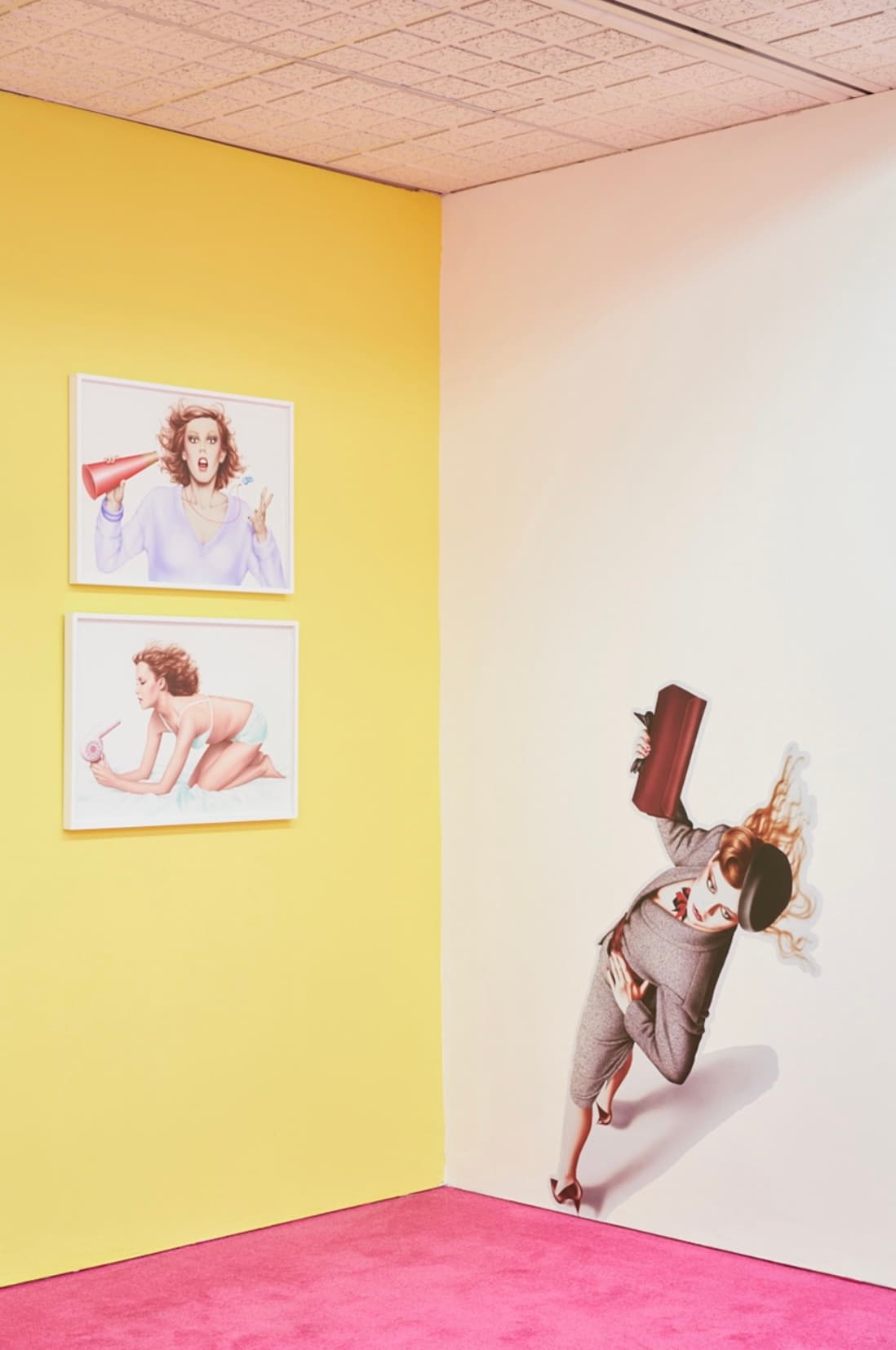Review: Harumi Yamaguchi at Project Native Informant, London
June 2017

There are no men to be seen here. Harumi Yamaguchi’s ‘Selected Works 1974–1985’ features instead 25 women, across 20 works on board and two wall vinyls. Born in 1941, Yamaguchi trained as an oil painter, but by the 1970s came to direct the advertising for PARCO, a flagship development in Tokyo’s Shibuya district, which sought to combine retail and creative activity with a consciously female focus. (The art director and copywriter appointed alongside Yamaguchi were also women.) In the same hybrid spirit, this pitch-perfect presentation (which follows an altogether more sober one at Tokyo’s NANZUKA) – with multi-coloured walls and a pink carpet picking out the cool, candy hues of Yamaguchi’s acrylics – draws no distinction between her commercial commissions and ‘pure’ creative endeavours; a video stack plays her PARCO advertisements on loop.
All of the works were made after Yamaguchi adopted the airbrush, something she shares with commercial artist forebears like Alberto Vargas. But, in Yamaguchi’s hands, this tool produces a very different effect: her subjects’ flesh has a hard, satiny quality, like powder-coated steel; Vargas’s kittenish pin-ups compare to them as pleasure barges to torpedoes. Which is not to say that Yamaguchi’s women don’t have fun as they skate, smoke and drink Coca-Cola. Their poses frequently imply a luxuriant but muscular movement: reaching (Dripping, 1974), gliding (Roller Skate, 1977), crawling (Fight Mode, 1976) or merely stretching, like the turbaned bather in Soap Bubbles (1979), who extends her leg in an implausibly upright, solid salute.
The show’s press release takes these as cues to position Yamaguchi as a feminist, her milieu rooted in the ūman ribu (women’s liberation) movement of the 1970s. In a 2001 essay (republished last year the catalogue for the NANZUKA show), the sociologist Chizuko Ueno argued that Yamaguchi ‘deconstructs male desire through her exaggerative depictions’, making the female body ‘a realm unreachable by male hands’. I don’t know if it’s so straightforward: firstly, because hyper-idealization can just as often be pernicious or possessive as positive, and, secondly, because the same book reveals a host of the artist’s works – for one, the masturbatory Stripper Story (1984) – which it’s hard not to see as scopophilic.
If they’re neither fully vestal virgins nor entirely sex objects, then who are ‘Harumi’s gals’? Perhaps predictably, given the commercial context Yamaguchi practised in, they’re consumers. And global ones at that. Just as the references I reach for – the demented domestic goddesses of Margaret Harrison, or the frenzied figures from Allen Jones’s 1973 Pirelli calendar – are Western, all but one of the subjects here appears Caucasian. Isolated on white pages, they don’t seem to inhabit a specific cultural realm, but a kind of non-place, in which things – held, used, consumed – are the only unifying reference.
In this sense, Yamaguchi’s work appears as a late flowering of postwar pop (a Warhol-ish print appears in the background of Banana Picture with Lady, 1982). In turn, this might be read as either a naive endorsement of capitalist stuff or a prophetic interrogation of it – a trivial project or, conversely, a fairly ambitious one. Surveying Yamaguchi’s ambigious idols, I incline towards the latter view. When Sylvia Plath’s The Bell Jar(1963) was reissued in 2013 with a cover depicting a woman applying lipstick, the writer Emily Witt reported in n+1, readers complained that Plath was being reduced to ‘chick-lit’. Witt saw nothing frivolous in the image: ‘women apply makeup every day,’ she wrote. ‘What the cover suggests is a book about a female experience.’ This smart and seductive show is a welcome interruption to familiar ideas of what art by and about women might look like.